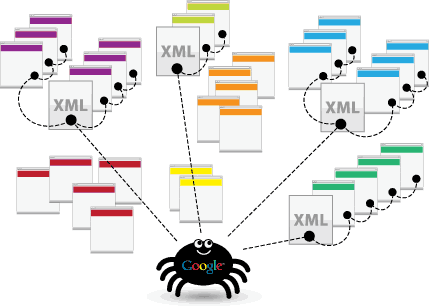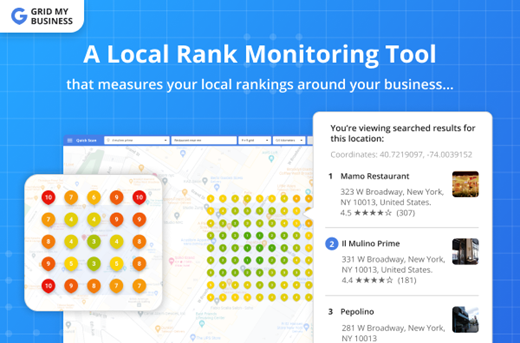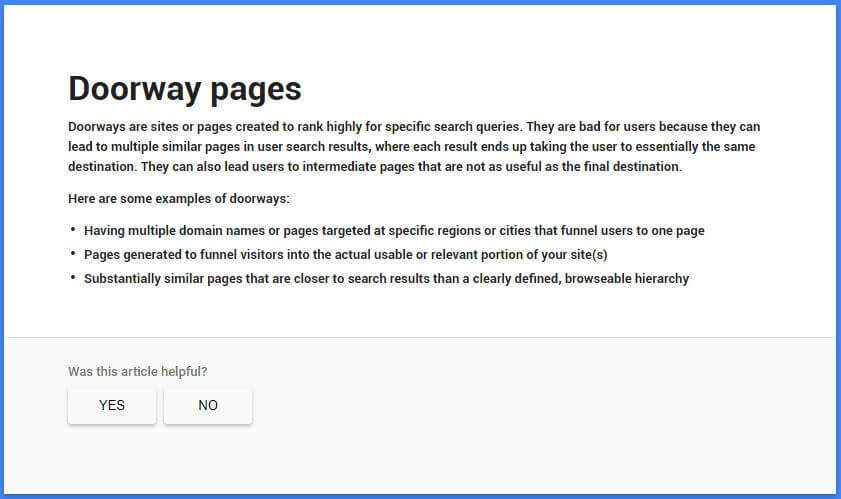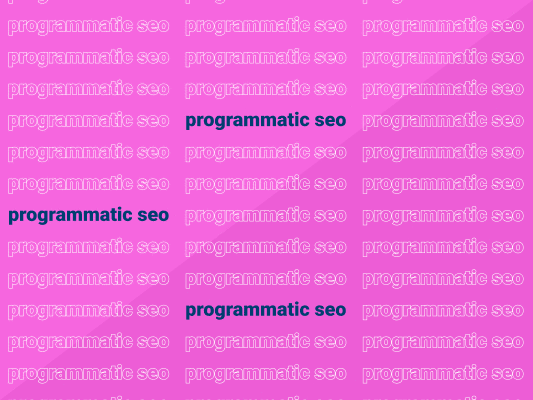Marketers today use programmatic SEO to find keywords, understand user intent and then create hundreds, if not thousands of landing pages using just lines of codes.
New to programmatic SEO? Learn more on this topic today.
Planning and executing an effective SEO strategy for a website with hundreds of pages isn’t an easy task. But it’s not impossible. There are strategies you can use to make the process simpler.
On a more fundamental level, SEO ensures your content shows up where your customers will find you when looking for your content or product/service. The internet has contributed to even more fierce competition in different industries with almost all of the world’s population having access to the internet.
However, amidst all this competition, SEO still isn’t a marketing element you can look at in isolation or easily dismiss. There are just so many strings to its bow.
Search engine optimization plays a critical role in any business’s digital and marketing campaign. Therefore, it’s always important to consider all aspects of your SEO and utilize it fully. One critical part of this task is to understand and implement programmatic SEO.
It might sound complicated for some marketers, but it doesn’t have to be.
What is Programmatic SEO?
Programmatic SEO is essentially the name given to your web page creation using code but at scale. A well-thought-out programmatic strategy for these web pages can be used to target multiple keyword variations, like creating landing pages.

Typically, you will find these pages in some of the major verticals such as eCommerce, travel, informational sites, and real estate. These verticals rely on programmatic search and strategy to build their SEO.
As such, you’ll need a dedicated web page for each product and category for your website. This setup can easily lead to hundreds of millions of web pages. The process makes programmatic SEO an efficient, functional, and user-friendly strategy.
However, like all other SEO strategies, it also comes with some SEO challenges.
You can use programmatic SEO to get your brand in front of the right audience with targeted content for local, voice, and mobile searches. One critical fact to note is that a programmatic strategy isn’t just about creating duplicate web pages to get your content out there for more people to see.
Programmatic search uses a technique that matches the total number of Google entries with modifiable, user-friendly content.
Unlike small websites, which rely more on manual content creation, programmatic SEO ensures your web pages are the main traffic-driving pages of your website.
Benefits of Implementing Programmatic SEO
There are many benefits to using programmatic SEO. For one, it works in a split second, literally. But speed aside, here are some of the major benefits of using programmatic search:
1. Bypass the Slow SEO Process

Programmatic SEO operates at lightning speed and will customize your user’s experience with your website, sparking their interest in engaging with your brand even more.
There has been a talk in the SEO about the 10x content speed increase and how it would boost your search rankings through the roof. An effective programmatic strategy is the best way to avoid the agonizingly slow SEO process.
The programmatic search focuses less on the quality of your content or its authoritativeness and more on creating a great user experience. You can now look forward to more high-volume landing web pages with transactional intent.
2. Focuses on Transactional Intent
Programmatic SEO is also very financially efficient. Therefore, depending on the programmatic strategy you’re using, your product users can pay on a few different billing schedules. However, using a shorter, 30-day cycle is an excellent strategy that will allow you to alter your payment scheme.
You no longer have to commit to the 90-day program. Additionally, it allows users to pay one invoice at a time instead of paying several invoices from traditional advertisers.
3. Reach Out to a Wide Range of People
Your programmatic SEO strategy will only be as limited as your marketing budget. You can use it to reach a massive audience while making many marketing decisions spontaneously.
Most businesses don’t always have the time or capability to engage with all their audiences in real-time. This becomes increasingly difficult as you engage with ad buying auctions across multiple platforms with millions of possibilities.
However, with a programmatic ad campaign, you’ll have the opportunity to select your desired market and target your advertisements for less work but greater effect. With this tool, you’ll be able to advertise your content better on social media and other online platforms, thereby allowing your audience to grow with your business.
How to Do Programmatic SEO

Whether you’re seeking brand visibility, bigger sales numbers, or simply high conversion rates, programmatic search, and paid search belong together.
Here are some programmatic web content strategies you should consider implementing in your web and content creation process:
1. Tons of Keyword Research
SEO is about capturing search traffic that’s relevant to your business or web page. Your target audience’s search intent can vary based on their keyword usage.
Keyword research is a reasonably known SEO strategy that can be quite different and effective when applied to scale. First, ensure you list your head terms, check your search volume using an SEO keyword research tool, identify your primary and secondary filters, include modifiers, and then put them together.
i. Find Head Terms
There are broader related search terms for products/services on any given website. Take Airbnb, for example. Its head terms will be vacations and trips. While ‘vacation’ is a high-volume keyword with searches attached to it, most searchers won’t just type vacation into their Google search queries. They will use modifiers related to the keyword for whittling down the results.
BiQ Keyword Intelligence is an excellent tool to help you find related keywords that your searchers are interested in.

BiQ’s Keyword Intelligence will provide you with critical insights like how many people are using your focus keyword to find your content online.
If you’re unsure which keyword to use, you can always sort the keywords on the tool based on their value. The more high-value keywords you use, the more potential they will have towards bringing more traffic to your web pages at a lower competition.
ii. Identify Modifiers
Google’s algorithms and searches help online users to find relevant and automatic search suggestions. Therefore, an SEO tool, such as BiQ Cloud, will help you find all your keyword suggestions along with the head keyword to create with modifiers.
By this stage, you probably have an idea of what your primary and secondary keywords will be. The primary modifiers will create a new keyword category, while the secondary modifiers will describe your head term, including the primary modifier.
iii. Local Modifiers
You can also use modifiers to include locality search terms, which usually look like the “head term + location” in the search query. You can also find a selection of local modifiers and their alternatives, depending on how you type and search for a specific keyword.
For instance, if your customer is searching for restaurants in New York, then the search query ‘restaurants in NY’ will also suffice and produce similar search results.
Other search terms like ‘head term + near me’ are also common among Google, as more people use it to find maps to local business locations.
One way you can look for keywords to use for local modifiers is by using Grid My Business.

This tool allows you to identify your local search ranking for specific search queries in specific locations. You can find out which search queries you rank highly for or don’t so you can create modifiers that use these search queries that allow potential customers to find you.
iv. Put All of Them in a List
After compiling your desired keywords in a list, you will typically have a lot of data to use on your site. In some cases, you may have over 100k search terms, which is great if you own a large-scale aggregator-style site.
The smaller numbers can also yield amazing search results for your website.
However, this programmatic SEO strategy aims to collect as many keywords and their modifiers as possible.
The use of the BiQ’s Collection feature is an excellent strategy to compile all the relevant keywords for your website and content creation needs. Ideally, for an effective programmatic strategy, you’ll need at least 2,000 keywords and search terms.
2. Do Competitive Research at a Large Scale
Now is the perfect time to find the big players for the search terms you’re shooting for. Typically, it’s always a great idea to analyze the top search results on Google. These links tend to have the most keywords.
You can also search your targeted keyword to see who some of your top competitors are in Google.

If you are using the keyword “programmatic SEO,” then some of your top competitors are Break the Web, Webflow, and Moz.
The next step requires you to find out the total number of keywords each competitor has. You can do this by searching their web domain in a keyword tool, such as BiQ Keyword Intelligence.
It is also a great strategy to look at your competitor’s backlinks, common user experience patterns, and tools they prefer using for their title tags.
BiQ’s Rank Intelligence is another excellent SEO tool you can use to determine how many and what your competitors are ranking for in Google. You can also use the Rank Intelligence feature to determine other important metrics like their search volume, cost-per-click, and so on.
BiQ Rank Intelligence will let you know the search terms your target audience might use to reach your website.
3. Make Landing Pages
The first step after doing your competition analysis is to make your landing pages.

Building landing pages is another tricky part of any programmatic strategy since thousands of web pages need to be different. However, it’s not impossible. You can actually create large volumes of unique landing pages within short periods using programmatic SEO.
If you have over 100,000 keywords, you don’t necessarily need to create 100,000+ landing pages. However, you will need to focus more on your target audiences’ search intent related to your keyword research. This is the best strategy since people use search results differently, depending on their ultimate goals.
As such, you’ll need to do in-depth research to determine what Google considers as specific keyword search intent. Google’s “searches related to” at the bottom of your search results page is known to provide some great keyword search intent results.

Sometimes, Google highlights some words in bold, which indicates that using those keywords might be an excellent choice for your website. BiQ’s Keyword Intelligence will help you check for keywords with search intent. It is the best SEO tool to help you determine whether your customer’s search intent is transactional, informational, or navigational.

This way, you will have relevant data to create even more relevant landing pages around your customers’ search intent related to your keyword research.
4. Avoid Creating Doorway Pages

Google doesn’t like doorway pages. So, you should do your best to avoid using them.
However, before you throw your programmatic SEO ideas into the garbage, this post aims to guide you on how to build your website at scale. Remember, Google forbids any link-building practice that isn’t “useful content.”
This post teaches you how to use programmatic strategy while still creating highly relevant and useful content for your target audience.
Provided your content has a real and genuine reason to exist, the search engine giant won’t kick it out.
5. Linking at a Scale
In writing, there are no paths or processes set in stone. The same goes for programmatic SEO. As a result, you’re on your own to figure out what works best for your website. Let’s provide you with a few strategies that will illuminate the path for you:
i. Content That Goes Viral
You will need to be very creative to make your content go viral. Think Buzzfeed. The website didn’t start with an insane budget but would grow into a monster publication to become what it is today.
Buzzfeed managed this by creating content they knew people would enjoy and share on their social media posts. They got so many backlinks that their content went viral multiple times.
ii. Data
Statista did a few in-depth and detailed surveys, which would see them grow to become one of the most popular go-to websites for original data on almost every topic, country, and state. And the website produces more and more content for its users daily.
6. Publish and Measure Performance (KPI)

As a content creator, you should always develop a habit of testing everything you can about your website. One of the benefits of working on a large-scale marketing and sales campaign is that you have unlimited access to big data to utilize for your SEO efforts.
You can use A/B split testing to test for web crawlers on your web pages.
Split your pages into two to three groups. Use one group as a control and enable the others. Using the A/B split test, you can test for the following data:
- Content length
- Adding structured data
- Page performance
- Image ALT tags
- Internal linking
- Changing keyword modifiers of SEO tags
It’s always recommended to use one experiment at a time before moving to the next one to determine the performance of each criterion. Google Search Console is the perfect tool to measure your KPI.
Conclusion
Programmatic SEO isn’t a walk in the park. However, it doesn’t have to be difficult either. If you’re looking to gain more organic traffic by publishing content at scale, then a programmatic strategy will significantly boost your marketing strategy.
Also, remember to create useful and relevant content for your users. Otherwise, Google will label your pages as problematic.
The strategies explained above will help you achieve a successful programmatic outcome. Try them out today!




